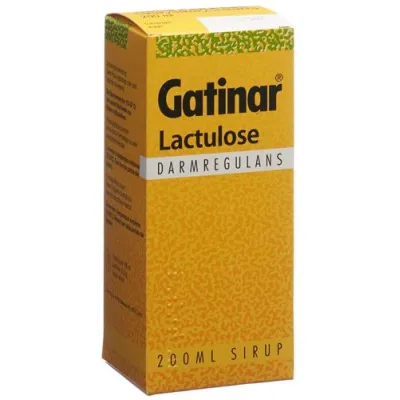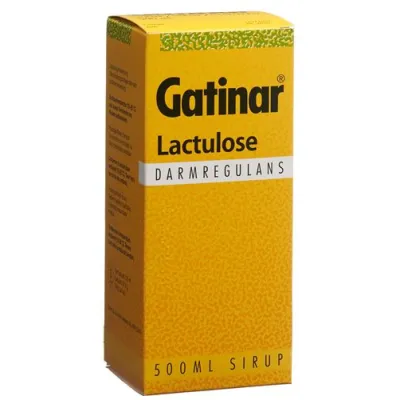lactulose syrup
(1 Pages)
Duphalac syrup bottle 200 ml
AMZV What is Duphalac and when is it used? The active ingredient in Duphalac is lactulose, a sugar that does not occur naturally. Since your body cannot digest or absorb Duphalac, it remains in the intestine and reaches the large intestine unchanged. There it causes an increase in acidity due to the conversion by the intestinal flora. This stimulates the colon. A larger amount of water is also retained in the large intestine, which allows for softening of the stool and easier elimination. In addition, the transfer of certain toxic substances from the intestinal contents into the blood circulation is prevented and they are excreted with the stool.Duphalac is taken for constipation, i.e. if you have problems emptying your stool. These difficulties can come in two forms: either no voiding at all, or then small and hard stools. Duphalac helps improve bowel movements. We also recommend that you adjust your daily habits as well. Below is some practical advice that may help you. Lactulose, as a prebiotic substance, can enhance the growth of health-promoting bacteria (such as Bifidobacteria and Lactobacillus) while suppressing potential disease-causing bacteria (such as Clostridium and Escherichia coli).This can result in a more favorable balance in the gut flora.The doctor can also use Duphalac to treat other diseases ( especially for liver disease).What needs to be considered?The following advice can help you break the bad habits that are a common cause of constipation:Regular physical activity.Drink enough water, at least 1.5 liters a day.Never skip a meal or start a diet until your bowels are working properly again.Get started for the day a good breakfast: wholemeal bread, fruit, coffee (not strong tea), yogurt.Don't suppress a bowel movement if you feel it.Never take a laxative for a long time without asking your doctor.Preferably eat unpeeled fruit, raw vegetables, nuts, figs, dried plums, wholemeal bread, rye bread, whey, yogurt.Eat calmly and chew every bite carefully.Avoid toast, white bread, rusks, strong tea, bananas, white rice, hard-boiled eggs.For diabetics15 ml of Duphalac syrup contain a maximum of 2.8 g absorbable carbohydrates.In normal doses, Duphalac can also be taken by diabetics.When can Duphalac not be used? If you are hypersensitive to the active ingredient or any of the ingredients. People who have been prescribed a galactose or lactose-free diet by their doctor should not take Duphalac. If there is an intestinal obstruction other than simple constipation, or if there is a tear or risk of a tear in the digestive tract, Duphalac must not be used. If in doubt, ask your doctor. When should you be careful while taking Duphalac? If after a few days you notice that your stools are too watery, it is enough to reduce the recommended doses. As a precautionary measure, you should consult your doctor before using any laxative in children under 6 years of age. The use of laxative in children should only be carried out exceptionally and under medical monitoring. Patients with the rare hereditary galactosis intolerance, Lapp lactase deficiency, fructose intolerance or glucose galactose malabsorption should not take. lead to the water and electrolyte equilibrium. Search your doctor or yoursConsult your doctor before starting treatment if you have painful abdominal pain of undetermined cause, so that this can be clarified.Inform your doctor, pharmacist or druggist, or your doctor, pharmacist or druggist if younotice after several days that the effectiveness of the drug is insufficient; it may be necessary to adjust the dose.suffer from lactose intolerancesuffer from other diseaseshave allergies ortake other medicines (including those you bought yourself!) or use them externally!Can Duphalac be taken during pregnancy or while breastfeeding?If used as directed, it can be taken during pregnancy and breastfeeding.As a precaution If possible, you should avoid taking medicines during pregnancy and breastfeeding or ask your doctor, pharmacist or druggist for advice.How do you use Duphalac?The dosage of Duphalac depends on your age, the severity of the constipation and how long the constipation has lasted.Duphalac can be taken undiluted or diluted in a warm or cold drink. A single dose should be swallowed immediately and not remain in the mouth for a long time.In the case of a single daily dose, these should be taken at the same time, e.g. during breakfast.ConstipationDuphalac can be taken as a single daily dose or in two divided doses.The initial dose can be individually adjusted after an adequate treatment result has been achieved. It may take some time (2-3 days) for the treatment to take effect. If the effect is too strong (stools too liquid or too large), the daily dose must be reduced or, on the contrary, increased if the effect is too weak.The table below clearly indicates the doses of Duphalac to be taken:Initial dose/day(1st to 3rd day)with prolonged useAdults and adolescents from 14 years15-45 ml10-25 mlChildren (7-14 years)15 ml10 mlChildren (1-6 years)5-10 ml5-10 mlInfants under 1 year≤5 ml≤5 mlThe dose can be measured exactly using the enclosed dosing cup (2.5 to 30 ml).Keep to the dosage given in the package insert or prescribed by the doctor. If you think that the medicine is too weak or too strong, talk to your doctor, pharmacist or druggist.What side effects can Duphalac have?The following side effects can occur when taking Duphalac:Especially at the beginning of treatment, temporary flatulence may occur, which you should not worry about. They are a sign of the effectiveness of Duphalac. During treatment, digestive disorders such as abdominal pain, nausea and vomiting, as well as, in the case of too high doses, diarrhea and disturbances in the water and electrolyte balance. If you notice any side effects that are not described here, you should inform your doctor, pharmacist or pharmacist. What else should you watch out for? The Medicines may only be used by the date marked «EXP» on the container.Store at room temperature (15-25 °C); Do not freeze syrup and protect from sunlight. Keep medicines out of the reach of children! Your doctor, pharmacist or druggist can provide you with further information. These people have the detailed technical information.Whatdoes Duphalac contain?Active ingredient15 ml Duphalac syrup contain 10.01 g lactuloseExcipientsNone; however, sulphites and other sugars such as lactose, galactose and fructose may be present.Authorization number32894 (Swissmedic).Where can you get Duphalac? Which packs are available? In pharmacies and drugstores, without a doctor's prescription: Duphalac, syrup in bottles: 200 ml, 500 ml and bundle pack 12 × 500 ml Authorization holder Mylan Pharma GmbH, 6312 Steinhausen This leaflet was last revised in June 2018 checked by the drug authority (Swissmedic)...
11.81 USD
Gatinar syrup 200ml
Gatinar is used for all forms of constipation, especially -after operations; -during pregnancy and lactation (after consultation with the doctor); -bedridden; -used to treat chronic constipation. The active ingredient in Gatinar - lactulose - is an artificial sugar that cannot be broken down by the human small intestine. It therefore reaches the large intestine unchanged, where it serves as a nutrient for the naturally occurring lactic acid bacteria. This produces acidic breakdown products, mainly lactic acid, which cause the large intestine to become slightly acidic. The putrefactive bacteria are inhibited in their growth and the restoration of the normal intestinal flora is promoted. At the same time, Gatinar and its degradation products have a hydrophilic (osmotic) effect. This will soften the stool and make it easier to empty. Gatinar allows for a natural correction of bowel movements without the risk of habituation or painful irritation. It can also be taken by pregnant women, breastfeeding women and diabetics in the indicated dosages and only after consulting a doctor (see also information below). A few hours after taking Gatinar, infants have soft stools. In adults, the conversion of the intestinal flora takes about 1-2 days. Swissmedic-approved patient informationGatinar® syrupMelisana AGAMZVWhat is Gatinar and when is it used?Gatinar is used in all forms of constipation, especially -after operations; -during pregnancy and lactation (after consultation with the doctor); -bedridden; -used to treat chronic constipation. The active ingredient in Gatinar - lactulose - is an artificial sugar that cannot be broken down by the human small intestine. It therefore reaches the large intestine unchanged, where it serves as a nutrient for the naturally occurring lactic acid bacteria. This produces acidic breakdown products, mainly lactic acid, which cause the large intestine to become slightly acidic. The putrefactive bacteria are inhibited in their growth and the restoration of the normal intestinal flora is promoted. At the same time, Gatinar and its degradation products have a hydrophilic (osmotic) effect. This will soften the stool and make it easier to empty. Gatinar allows for a natural correction of bowel movements without the risk of habituation or painful irritation. It can also be taken by pregnant women, breastfeeding women and diabetics in the indicated dosages and only after consulting a doctor (see also information below). A few hours after taking Gatinar, infants have soft stools. In adults, the conversion of the intestinal flora takes about 1-2 days. What should be considered?If you suffer from chronic constipation, we recommend that you see your doctor. If you are constipated, you should, if possible, eat high-fiber food (vegetables, fruit, wholemeal bread) and drink plenty of fluids regularly and pay attention to physical activity (sport). Note for diabetics: This medicinal product contains 1.8 g of digestible carbohydrates per single dose (10 ml). When should Gatinar not be taken?The preparation should not be taken in diseases of the gastrointestinal tract. Gatinar should not be taken in the case of milk sugar intolerance (lactose intolerance) or a congenital metabolic disease in the infant (galactosemia). When should you be careful when taking Gatinar?Like any laxative, Gatinar can reduce the loss of potassium caused by other medicines (e.g. certain diuretics, corticosteroids, etc.). become, strengthen. This is of particular importance in patients treated with drugs that affect the heart (cardiac glycosides, antiarrhythmics). They should therefore only use Gatinar under strict doctor's instructions. Inform your doctor, pharmacist or druggist if you suffer from other illnesses, have allergies or are taking other medicines (even those you bought yourself!) or using them externally! Can Gatinar be taken during pregnancy or breastfeeding?Based on previous experience, there is no known risk for the child when used as directed. However, systematic scientific investigations have never been carried out. As a precaution, you should avoid taking medicines during pregnancy and breastfeeding or ask your doctor or pharmacist for advice. How do you use Gatinar?Infants Toddlers 1-5 years old Children 6-14 years old Adults 2.5-5 ml daily in a bottle 5-10ml daily in a drink after a meal10-15ml daily in a drink after a meal15-30 ml daily divided into 3 doses of 5-10 ml in a drink after or during meals. For the most accurate dosing, use the enclosed measuring cup. It is strongly recommended to start with the low starting dose. Too high an initial dose could lead to increased gas formation and flatulence, as the bacterial metabolism is temporarily stimulated by restoring the normal intestinal flora. This can be avoided by gradually increasing the daily dose to the individual optimal amount. The rebalancing of the intestinal flora makes it possible to reduce the specified dose after 3-4 days, even in cases of chronic constipation. It is also possible to alternate one or more drug-free days over time. If the constipation lasts only a short time, the drug is of course discontinued after the stool has returned to normal. Stick to the dosage given in the package leaflet or as prescribed by your doctor. If you think the medicine is too weak or too strong, talk to your doctor, pharmacist or druggist. What side effects can Gatinar have?The following side effects can occur when taking Gatinar: In rare cases, especially at the beginning of treatment, the preparation can cause flatulence or abdominal cramps. With high doses, prolonged or too frequent use, diarrhea with loss of water and disturbances in the mineral balance (e.g. loss of potassium) can occur. If you notice side effects that are not described here, you should inform your doctor, pharmacist or druggist. What else needs to be considered?The medicinal product may only be used up to the date marked «EXP» on the container. Your doctor, pharmacist or druggist can provide you with further information. These people have the detailed information for specialists. Gatinar should be kept out of the reach of children. Store at room temperature (15-25°C). What does Gatinar contain?100 ml of Gatinarcontain 67 g of lactulose. Note for diabetics: 10 ml of Gatinar correspond to 0.18 bread units. See the section «What should be considered?». Approval number37585 (Swissmedic). Where can you get Gatinar? What packs are available?In pharmacies and drugstores, without a doctor's prescription. Bottles of 200 ml and 500 ml. Authorization holderMelisana AG, 8004 Zurich. This leaflet was last checked by the drug authority (Swissmedic) in June 2013 . ..
17.14 USD
Gatinar syrup 500ml
What is Gatinar and when is it used? Gatinar is used in all forms of constipation, especially -after operations; -during pregnancy and breastfeeding (after consultation with the doctor); -in the case of bedridden; -to treat chronic constipation human small intestine cannot be broken down. It therefore reaches the large intestine unchanged, where it serves as a nutrient for the naturally occurring lactic acid bacteria. This produces acidic breakdown products, mainly lactic acid, which cause the large intestine to become slightly acidic. The putrefactive bacteria are inhibited in their growth and the restoration of the normal intestinal flora is promoted. At the same time, Gatinar and its degradation products have a hydrophilic (osmotic) effect. This will soften the stool and make it easier to empty. Gatinar allows for a natural correction of bowel movements without the risk of habituation or painful irritation. It can also be taken by pregnant women, breastfeeding women and diabetics in the indicated dosages and only after consulting a doctor (see also information below). A few hours after taking Gatinar, infants have soft stools. In adults, the conversion of the intestinal flora takes about 1-2 days.What should you pay attention to?If you suffer from chronic constipation, we recommend that you consult your doctor. In the event of constipation, you should, if possible, eat fiber-rich food (vegetables, fruit, whole-grain bread) and drink plenty of fluids regularly and exercise (sport). Note for diabetics: This medicine contains 1.8 g of digestible carbohydrates per single dose (10 ml). When shouldn't Gatinar be taken? The preparation should not be taken in diseases of the gastrointestinal tract. Gatinar should not be taken if the infant has milk sugar intolerance (lactose intolerance) or a congenital metabolic disease (galactosemia).When should caution be taken when taking Gatinar?Like any laxative, Gatinar can increase potassium losses caused by other medicines (e.g. certain diuretics, corticosteroids, etc.). This is of particular importance in patients treated with drugs that affect the heart (cardiac glycosides, antiarrhythmics). They should therefore only use Gatinar under strict doctor's instructions.Inform your doctor, pharmacist or druggist, or your doctor, pharmacist or druggist if you suffer from other illnesses, have allergies or are taking other medicines (even those you bought yourself!) or use them externally!Can Gatinar be taken during pregnancy or while breastfeeding?Based on previous experience there is no known risk for the child when used as intended. However, systematic scientific investigations have never been carried out. As a precaution, you should avoid taking medicines during pregnancy and breast-feeding, or ask your doctor or pharmacist for advice.How do you use Gatinar?InfantsToddlers aged 1-5Children aged 6-14Adults2.5–5 ml daily in a bottle5–10 ml daily in a drink after a meal10–15 ml daily in a drink after a meal15-30 ml daily divided into 3 doses of 5-10 ml in a drink after or during meals.For the most accurate dosing, use the enclosed measuring cup.It is highly recommended to use to begin with the low starting dose. Too high an initial dose could lead to increased gas formation and flatulence, as the bacterial metabolism is temporarily stimulated by restoring the normal intestinal flora. This can be avoided by gradually increasing the daily dose to the individual optimal amount. The rebalancing of the intestinal flora makes it possible to reduce the specified dose after 3-4 days, even in cases of chronic constipation. It is also possible to alternate one or more drug-free days over time. If the constipation lasts only for a short time, the drug will of course be discontinued after the stool has returned to normal.Observe the dosage specified in the package insert or prescribed by the doctor. If you think the medicine is too weak or too strong, talk to your doctor, pharmacist or druggist.What side effects can Gatinar have?The following side effects can occur when taking Gatinar:In rare cases, especially at the beginning of treatment, the preparation can cause flatulence or abdominal cramps. With high doses, prolonged or too frequent use, diarrhea with loss of water and disturbances in the mineral balance (including loss of potassium) can occur.If you notice any side effects that are not described here, you should inform your doctor, pharmacist or druggist.What else needs to be considered?The medicine may only be used up to the date marked "EXP" on the container.Your doctor, pharmacist or druggist can provide you with further information. These people have the detailed technical information. Gatinar should be kept out of the reach of children. Store at room temperature (15-25°C). What does Gatinar contain? 100 ml of Gatinar contain 67 g of lactulose. Note for diabetics: 10 ml of Gatinar correspond to 0.18 bread units. See the section «What should be considered?».Approval number37585 (Swissmedic).Where can you get Gatinar? Which packs are available? In pharmacies and drugstores, without a doctor's prescription. Bottles of 200 ml and 500 ml. Authorization holder Melisana AG, 8004 Zurich. This leaflet was last checked by the drug authority (Swissmedic) in June 2013....
33.70 USD
(1 Pages)



